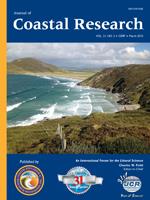Makowski, C.; Finkl, C.W., and Vollmer, H.M., 2015. Geospatially integrated seafloor classification scheme (G-ISCS): A new method for cognitively interpreting benthic biogeomorphological features.
Because benthic environments show ecotonal successions that biophysically fuse geomorphological units with biological coverages, there is a need for cognitive biogeomorphological classification methods. This study introduces a new geospatially integrated seafloor classification scheme (G-ISCS) methodology for cognitively interpreting geomorphological components and dominant biological covers from a variety of remotely sensed imagery within a geographic information system interface. An ordered, hierarchical classification scheme was thus developed to discriminate various categories such as physiographic realm, morphodynamic zone, geoform, landform, dominant surface sediment, dominant biological cover, and density of dominant biological cover. When applying the G-ISCS method to multispectral satellite imagery (e.g., GeoEye IKONOS-2), individual raw scenes were imported into IDRISI© Taiga to enhance frequency distributions of spectral reflectance through contrast stretching. Image enhancement was applied to blue, green, and red wavelength bands and combined to create 24-bit color composite images that were suitable for interpretation. Using ESRI ArcGIS® ArcMap software, raster catalogs were created for enhanced imagery data sets and projected on an interactive SmartBoard® overlay system for real-time, on-screen digitizing of seafloor feature boundaries at a nominal scale of 1:6000. Differentiation of marine environments was based on spectral reflectance characteristics of color, tone, saturation, pattern, and texture of the seafloor topology. Individual thematic subset maps were then created by hierarchical category and amalgamated in ArcMap to create interactive benthic environment maps. Attribute tables were compiled in conjugation with thematic map products to quantify relationships between mapping units, as well as to generate accurate biogeomorphological spatial statistics. Overall, the new G-ISCS method can be applied across multiple remote sensing platforms to cognitively delineate and interpret benthic biogeomorphological features along shelf environments.





